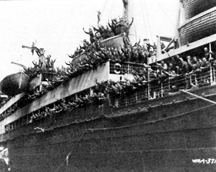Two Decades Later
The Second World War
How proudly the flag waved overhead, the bands played and the troops marched away from the reserves, the isolated villages, the city streets. We were Canadian Native soldiers . . . warriors in a proud tradition stretching back over the thousands of years into the dim past. We travelled by ship, by plane . . . and mostly on foot. In a dozen places—France, Germany, Italy... Japan—we raised our flags, and were buried in those foreign soils.53
The Response

In August 1940 the 2nd Canadian Infantry Division sailed for Great Britain. During six years of war, more than one million Canadian men and women enlisted, including at least 3,000 First Nations members and an unknown number of other Indigenous people. (A.E. Armstrong / Department of National Defence / Library and Archives Canada / PA-114797)
Canada declared war on Germany on September 10, 1939, and, for the second time in little more than two decades, the nation's Indigenous population responded quickly. As the Director of the Indian Affairs Branch of the Department of Mines and Resources noted:
They were not slow to come forward with offers of assistance in both men and money. About one hundred Indians had enlisted by the end of the fiscal year [March 1940] and the contribution of the Indians to the Red Cross and other funds amounted to over $1,300.54
Six years later the branch would report a total of 3,090 participants—including 72 women and seven First Nations members from the Yukon. However, the actual number of Indigenous recruits was likely higher than the figure recorded, since, again, some First Nations members and most Métis and Inuit were excluded from Indian Affairs' tally. As well, it was not known how many Indigenous people who no longer held official status served. Furthermore, an unknown number of Indigenous people from reserves near the Canada-United States border served with American Forces.
In contrast to the earlier war, most Indigenous peoples were not exempt from conscription. Compulsory service for home defence began in June 1940. This required a nationwide registration of everyone over the age of 16, so that the government could direct both national military service and any civilian labour that was related to the war effort. In 1942, compulsory overseas service was introduced, and the following year the government declared that, as British subjects, all able First Nations men of military age could be called up for training and service in Canada or overseas. Only the Inuit were exempt.

An Ojibwa from the Nipigon region of Ontario, Joan Martin (right) extended a family tradition by joining the Canadian Army. Her father, Ambrose served—and was wounded—during the First World War. Two of Joan's brothers, Lawrence and Ben, served in the Second World War, as did she. Along with their brother Ivan, the Martin boys later volunteered to go to Korea. (Lawrence Martin)
Many First Nations bands responded to the government's declaration with protest marches and petitions delivered to Ottawa. Their members questioned their requirement to serve in this war, when they had been exempt from compulsory service in the previous one. The First Nations conscription issue was raised in the House of Commons several times. In late 1944, it received the attention of the War Cabinet Committee, which decided to exempt some First Nations members: those from bands that had been assured during treaty negotiations that their members need never fear involvement in British battles. In all this affected more than 20,000 men.55
It is unlikely that many Indigenous men were among the approximately 2,500 Canadian conscripts sent to the front between late 1944 and the end of the war. By that time, most able-bodied First Nations men were already serving voluntarily. As early as 1942, opposition member John Diefenbaker noted in the House of Commons, "In Western Canada the reserves have been depleted of almost all the physically fit men."56 The same could be said of reserves across Canada.
- Date modified: